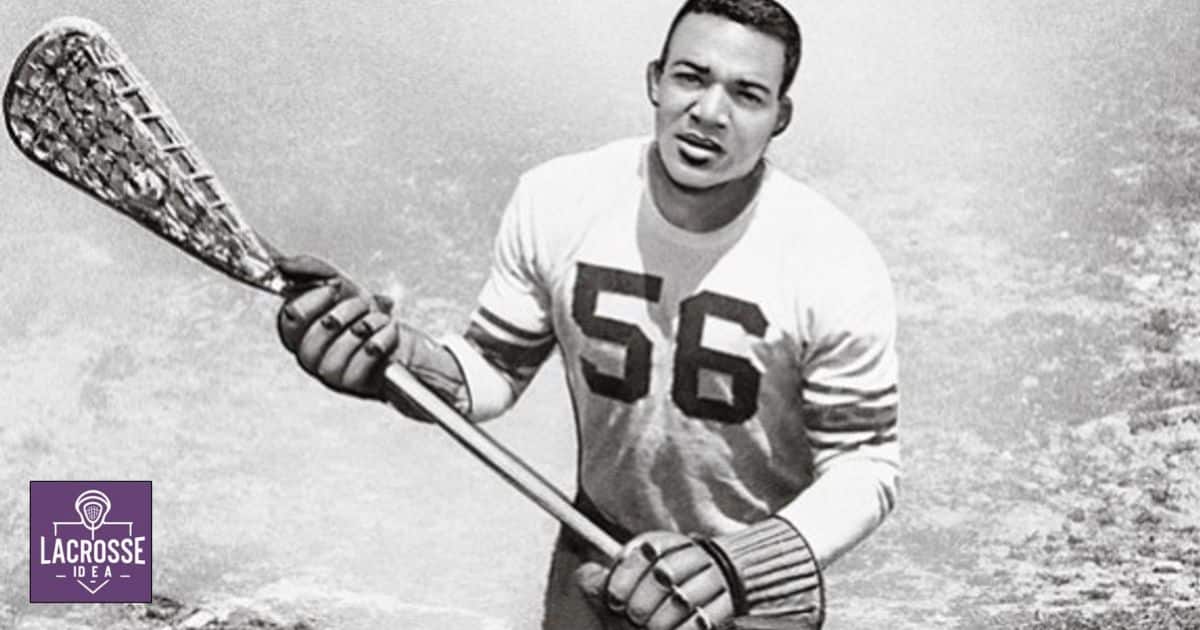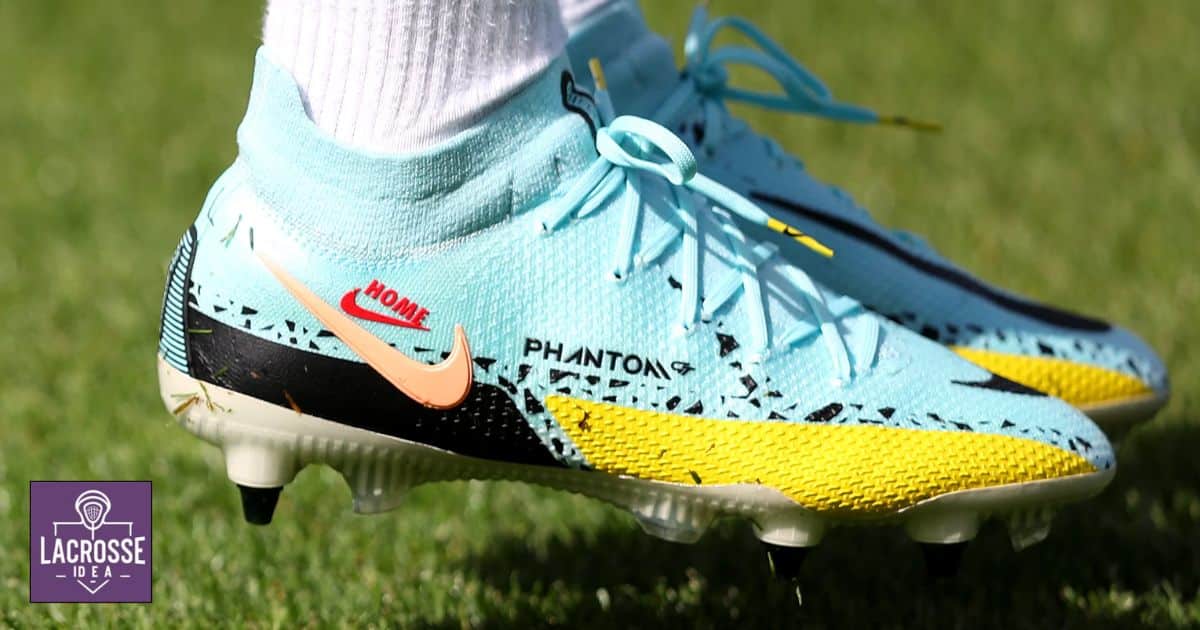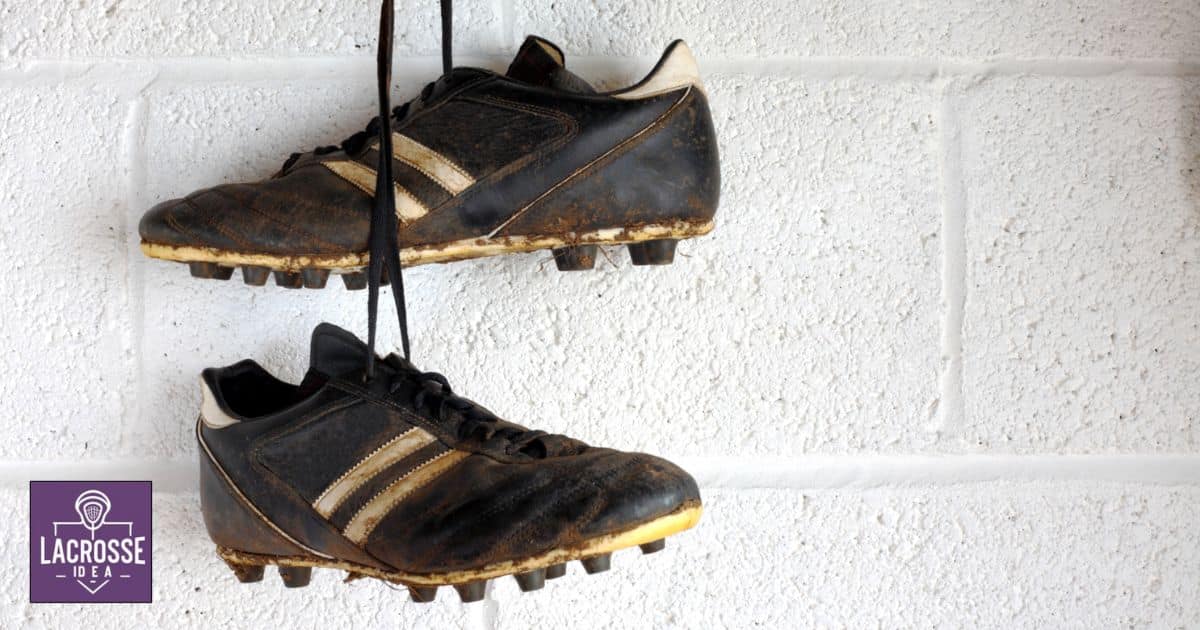Are you a lacrosse player considering wearing football cleats on the field? In the world of sports, sometimes unconventional choices can yield surprising results. This article explores the question: can you wear football cleats for lacrosse? By examining the similarities and differences between these two types of cleats, analyzing their performance in terms of traction and grip, and considering expert opinions, we aim to provide you with a comprehensive understanding of the potential benefits and drawbacks of wearing football cleats for lacrosse.
Key Takeaways
- Football cleats and lacrosse cleats have similarities in design and functionality, making football cleats a viable option for lacrosse players seeking optimal performance.
- The primary distinction between football and lacrosse cleats lies in their design and functionality, with football cleats designed for optimal traction on grass and lacrosse cleats providing traction on both grass and turf.
- The performance of football cleats in lacrosse is primarily determined by their traction and grip on different playing surfaces, and lacrosse players should consider the specific playing conditions and surfaces they will encounter before deciding to wear football cleats.
- While football cleats can enhance agility and provide additional ankle support, they may not be specifically designed for the movements and demands of lacrosse and may increase the risk of injury on the field. Specialized lacrosse cleats offer distinct advantages in terms of performance and reducing potential drawbacks.
The Similarities Between Football and Lacrosse Cleats
Football and lacrosse cleats share several similarities in terms of design and functionality. When it comes to traction comparison, both types of cleats are designed with specialized studs or spikes on the outsole to provide maximum grip and prevent slipping on the field. These studs are strategically placed to enhance stability and agility, allowing players to make quick cuts, change direction, and maintain balance during intense gameplay.
Additionally, both football and lacrosse cleats are constructed with durable materials such as synthetic leather or mesh to withstand the rigorous demands of the sport. This ensures longevity and performance benefits, providing players with the necessary support and protection for their feet. Whether it’s on the football field or the lacrosse field, these similarities in design and functionality make football cleats a viable option for lacrosse players seeking optimal performance.
The Differences Between Football and Lacrosse Cleats
When comparing football and lacrosse cleats, the primary distinction lies in their design and functionality. One major difference is the traction on different playing surfaces. Football cleats are designed to provide optimal traction on grass, while lacrosse cleats are designed to provide traction on both grass and turf. This difference in traction can have a significant impact on performance and agility.
Football cleats, with their longer and more widely spaced studs, offer better stability on grass, allowing players to make quick cuts and changes in direction. On the other hand, lacrosse cleats have shorter and more closely spaced studs, which provide better traction on both grass and turf, enabling players to maintain their agility and speed on different surfaces. Overall, choosing the appropriate cleats for each sport can greatly enhance a player’s performance and reduce the risk of injury.
Traction and Grip: How Football Cleats Perform in Lacrosse
The performance of football cleats in lacrosse is primarily determined by their traction and grip on different playing surfaces. Lacrosse fields can vary in terms of their conditions, ranging from natural grass to artificial turf. Football cleats typically have longer and wider studs or spikes compared to lacrosse cleats, which are designed for quick movements and changes of direction on grass.
While football cleats may provide excellent traction on grass, they may not perform as well on artificial turf, where shorter and more numerous studs are needed. The impact of football cleats on agility and quick movements in lacrosse can be affected by the type of playing surface. It is important for lacrosse players to consider the specific playing conditions and surfaces they will encounter before deciding to wear football cleats.
Potential Benefits of Wearing Football Cleats for Lacrosse
Football cleats can offer several potential benefits for lacrosse players. Firstly, the traction provided by football cleats on turf can enhance a player’s ability to make quick cuts and changes in direction, improving their overall agility on the field. Secondly, the high-top design of football cleats can provide additional ankle support and stability, reducing the risk of injuries during intense gameplay. Lastly, the durable construction of football cleats allows them to withstand the rough terrain and aggressive movements involved in lacrosse, ensuring long-lasting performance.
Traction on Turf
For optimal performance on turf, lacrosse players can benefit from utilizing the traction provided by football cleats. Lacrosse is a fast-paced sport that requires quick movements, sudden changes in direction, and explosive acceleration. When playing on turf, whether it is natural grass or artificial turf, having proper traction is essential to maintain stability and maximize performance.
Football cleats are designed with studs or spikes that provide superior traction on grass surfaces. These cleats dig into the ground, allowing players to push off and change direction quickly without slipping. The added grip and stability provided by football cleats can give lacrosse players a competitive edge, enabling them to make faster cuts, accelerate more efficiently, and maintain better control of their movements on the field.
Ankle Support and Stability
Utilizing football cleats for lacrosse can provide enhanced ankle support and stability, optimizing performance on the field. Ankle support is crucial in any sport, especially in lacrosse, where quick changes in direction and sudden movements put a lot of strain on the ankles. Football cleats are designed with a higher cut that extends above the ankle, providing additional support and reducing the risk of injury. This added support can give players more confidence to make aggressive moves without fear of rolling or twisting their ankles.
Furthermore, football cleats are engineered to offer exceptional traction and grip on various surfaces, including grass and artificial turf. The cleat configuration, typically featuring longer and more aggressive studs, helps players maintain their footing and stability while running, cutting, and stopping. This enhanced traction can be particularly beneficial in lacrosse, where quick movements and sudden changes in direction are common.
Durability on Rough Terrain
One advantage of wearing football cleats for lacrosse is their durability on rough terrain. Lacrosse is a sport that often takes place in outdoor environments, which can include muddy fields and wet conditions. In such situations, the durability of football cleats can prove to be beneficial. Football cleats are designed to withstand the rigors of the game, including the impact of running, cutting, and tackling.
This durability translates well to the rough terrain that lacrosse players often encounter. By wearing football cleats, lacrosse players can have confidence in their footwear’s ability to withstand the challenges of the game, regardless of the conditions. This can have a positive impact on their performance, allowing them to focus on the game without worrying about the durability of their footwear.
Potential Drawbacks of Wearing Football Cleats for Lacrosse
While football cleats may provide some advantages for lacrosse players, there are also potential drawbacks to consider. One drawback is that football cleats are not specifically designed for the movements and demands of lacrosse, which could impact a player’s performance. Additionally, football cleats may not provide the same level of ankle support and traction needed for quick changes in direction and agility, increasing the risk of injury on the lacrosse field.
Lacrosse-Specific Shoe Benefits
Lacrosse-specific shoes offer distinct advantages over football cleats, ensuring optimal performance and reducing the risk of potential drawbacks. These specialized cleats are designed with specific features that cater to the demands of the lacrosse game. Let’s take a look at some of the advantages of wearing lacrosse-specific shoes:
| Advantages | Description | Benefits |
|---|---|---|
| Enhanced traction | Cleats with a pattern designed for quick direction changes | Improved grip and stability on the field |
| Lightweight design | Lighter materials for increased speed and agility | Faster movements and reduced fatigue |
| Ankle support | High-top construction for added stability and protection | Reduced risk of ankle sprains and injuries |
| Breathability | Mesh panels and ventilation systems for airflow | Enhanced comfort and reduced sweat buildup |
| Flexibility | Softer materials and flexible soles for natural movement | Increased maneuverability and responsiveness |
Increased Risk of Injury
What are the potential drawbacks and increased risk of injury associated with wearing football cleats for lacrosse? While football cleats may provide some benefits for certain aspects of lacrosse, there are safety considerations that need to be taken into account. Football cleats are designed specifically for the demands of football, which differ from the requirements of lacrosse. The increased risk of injury comes from the differences in traction and support provided by football cleats compared to lacrosse-specific shoes.
The studs on football cleats are often longer and more widely spaced, which can lead to an increased risk of ankle injuries and instability on the lacrosse field. Additionally, the lack of lateral support in football cleats may put players at risk for sprained ankles and other lower extremity injuries. These potential drawbacks highlight the importance of considering safety when choosing the appropriate footwear for lacrosse.
As we explore the safety considerations, it is crucial to answer the question: are football cleats suitable for lacrosse?
Safety Considerations: Are Football Cleats Suitable for Lacrosse
Are football cleats a safe option for playing lacrosse? When considering the use of football cleats for lacrosse, it is important to take into account the safety considerations. Here are some key points to keep in mind:
- Pros and cons of using football cleats for lacrosse:
- Pros: Football cleats often have superior traction, providing stability and grip on various playing surfaces.
- Cons: Football cleats may not provide the same level of ankle support as lacrosse-specific cleats, increasing the risk of ankle injuries.
- Comparison of performance between football and lacrosse cleats in different playing conditions:
- Football cleats excel on grass fields, offering excellent traction and grip.
- Lacrosse cleats are designed for quick movements on turf or artificial surfaces, providing optimal traction and support.
While football cleats may offer some advantages, it is recommended to use lacrosse-specific cleats for optimal safety and performance in the sport.
Durability: How Well Do Football Cleats Hold Up in Lacrosse
When considering the durability of football cleats for lacrosse, it is important to assess their ability to withstand the demands of the sport. Football cleats are designed to provide traction and stability on grass or turf, whereas lacrosse cleats are specifically engineered to support the quick movements and agility required in the game. Football cleats are generally heavier and have longer studs, which can impede the player’s ability to change direction quickly.
Additionally, the materials used in football cleats may not be as durable as those used in lacrosse cleats, potentially resulting in premature wear and tear. While football cleats may offer some advantages, such as increased ankle support, they may not hold up as well in the rigorous conditions of lacrosse. Therefore, it is recommended to use lacrosse cleats for optimal durability and performance in the sport.
Performance Comparison: Football Cleats Vs. Lacrosse Cleats
When it comes to comparing the performance of football cleats and lacrosse cleats, there are several key differences to consider. Football cleats are designed to provide stability and traction on grass or turf, while lacrosse cleats are specifically engineered for the demands of the lacrosse field. Lacrosse cleats typically have shorter and more numerous cleats to enable quick movements, while football cleats have longer cleats for better traction in a straight line.
Football Vs. Lacrosse Cleats
The performance of football cleats differs from that of lacrosse cleats. While both types of cleats are designed to provide traction and support on the field, there are certain characteristics that set them apart. Here are some key differences between football and lacrosse cleats:
- Pros and cons of using multi-sport cleats for lacrosse:
- Pros: Multi-sport cleats offer versatility and can be used for both football and lacrosse. They can save you money by eliminating the need to purchase separate cleats for each sport.
- Cons: Multi-sport cleats may not provide the same level of performance and specialized support as sport-specific cleats. They may lack certain features that are essential for optimal performance in lacrosse.
- Impact of cleat design on performance in football and lacrosse:
- Football cleats are typically higher and offer more ankle support to protect against injuries from lateral movements and tackles. They also have thicker and longer studs to provide stability on grassy surfaces.
- Lacrosse cleats are lower and lighter to allow for quick movements and agility. They have shorter studs to enhance traction on turf fields.
Understanding the differences between football and lacrosse cleats is crucial in choosing the right footwear for optimal performance and safety in each sport.
Performance Differences Analyzed
Continuing the analysis of performance differences between football cleats and lacrosse cleats, it is important to note the varying levels of traction and support they provide on the field. When it comes to traction on grass, lacrosse cleats are specifically designed to offer optimal grip. The cleat patterns on lacrosse cleats are typically more aggressive, with deeper and more numerous studs, allowing for better traction and stability during quick direction changes and sudden stops.
On the other hand, football cleats may not provide the same level of traction on grass due to their less aggressive stud patterns. However, football cleats are designed to perform well on different playing surfaces, such as artificial turf or indoor courts, offering versatility for players who participate in various sports. So, while football cleats may not provide the same level of traction on grass as lacrosse cleats, they can still deliver solid performance on different playing surfaces.
Expert Opinions: What Coaches and Players Say About Using Football Cleats in Lacrosse
Several coaches and players unanimously agree that wearing football cleats for lacrosse can significantly impact performance on the field. While football cleats may seem similar to lacrosse cleats at first glance, there are key differences that make them less suitable for the game of lacrosse. Here’s what coaches and players have to say about using football cleats in lacrosse:
- Lack of traction: Football cleats have longer and thicker studs designed for gripping the grass on a football field. However, in lacrosse, where quick changes of direction are common, football cleats can cause players to slip and lose traction.
- Lack of ankle support: Lacrosse involves a lot of lateral movements and quick pivots. Football cleats often lack the necessary ankle support to prevent injuries during these movements.
- Reduced agility: Football cleats are generally heavier and bulkier than lacrosse cleats, which can hinder players’ agility and speed on the lacrosse field.
Alternatives to Football Cleats for Lacrosse Players
While football cleats may not be suitable for lacrosse, there are several alternative footwear options that can provide the necessary traction, ankle support, and agility for lacrosse players. These alternatives to football cleats include lacrosse specific shoes, which are designed specifically for the demands of the sport. Lacrosse specific shoes offer several advantages over football cleats. Firstly, they have specialized traction patterns that are optimized for the movements and playing surfaces in lacrosse.
This ensures better grip and stability during quick direction changes and cuts. Secondly, lacrosse specific shoes often have reinforced ankle support, which is crucial for preventing injuries in a sport that involves frequent lateral movements and physical contact. Lastly, these shoes are designed to be lightweight and flexible, allowing for enhanced agility and quick movements on the field. In conclusion, lacrosse specific shoes are the ideal alternatives to football cleats for lacrosse players, offering superior performance and protection.
Tips for Transitioning From Football Cleats to Lacrosse Cleats
To successfully transition from football cleats to lacrosse cleats, it is important to carefully select the appropriate footwear that aligns with the specific demands of the sport. Lacrosse cleats are designed to provide optimal performance on the field, allowing players to make quick cuts, change directions, and maintain stability. Here are some tips to help you make a smooth transition:
- Consider the playing surface: Lacrosse cleats come in different styles for different field conditions. Make sure to choose cleats that are suitable for the type of surface you will be playing on, whether it’s grass, turf, or a combination of both.
- Focus on ankle support: Lacrosse involves a lot of lateral movements, so it is crucial to have proper ankle support. Look for cleats that provide a secure fit and have features like high ankle collars or sturdy lacing systems to prevent injuries.
- Compare performance features: Take the time to compare the performance features of different lacrosse cleats. Look for features like lightweight construction, traction patterns, and cushioning systems that can enhance your performance on the field.
Final Verdict: Can You Wear Football Cleats for Lacrosse?
Although football cleats may seem similar to lacrosse cleats, they are not recommended for use in the game of lacrosse due to several key differences in design and functionality. While there may be some potential benefits of wearing football cleats, such as increased traction on grass and durability, these advantages do not outweigh the increased risk of injury that comes with wearing the wrong type of cleats for a specific sport.
Lacrosse cleats are specifically designed to provide the necessary support, stability, and maneuverability required for the quick and dynamic movements involved in the game. Wearing football cleats in lacrosse can lead to decreased agility, lack of ankle support, and an increased likelihood of slipping or getting caught on the playing surface. To illustrate the differences between football cleats and lacrosse cleats, the following table highlights some key factors:
| Football Cleats | Lacrosse Cleats |
|---|---|
| Designed for football | Specifically designed for lacrosse |
| Typically have longer studs for grass surfaces | Shorter studs for turf or grass surfaces |
| Focus on traction and stability | Focus on agility and quick movements |
Frequently Asked Questions
Can You Wear Lacrosse Cleats for Football?
While there may be similarities between lacrosse and football cleats, it is not recommended to wear lacrosse cleats for football. Football cleats are designed specifically for the demands of the sport, offering better traction and support.
Are Football Cleats Allowed in Lacrosse?
While football cleats may provide traction on the lacrosse field, they are not designed for the specific movements and requirements of the sport. Wearing football cleats in lacrosse can pose safety concerns and negatively impact performance.
Do Football Cleats Provide Better Traction Than Lacrosse Cleats?
Football cleats and lacrosse cleats offer different types of traction, with football cleats typically providing better traction on grass and lacrosse cleats designed for quick movements on turf. Factors such as playing surface and personal preference should be considered when choosing between the two.
Are Football Cleats More Durable Than Lacrosse Cleats?
Football cleats are generally designed with durability in mind, as they need to withstand the demands of the sport. However, when it comes to lacrosse, the specific requirements of the game may favor the use of lacrosse cleats for optimal performance and safety.
What Are Some Alternative Options to Football Cleats for Lacrosse Players?
Alternative footwear for lacrosse players includes lacrosse cleats, which are specifically designed for the sport’s requirements. Specialized cleats provide benefits such as improved traction, agility, and stability, enhancing performance and reducing the risk of injuries during lacrosse play.
Conclusion
In conclusion, while it is possible to wear football cleats for lacrosse, it is not recommended due to the differences in design and functionality. Football cleats may provide less traction and grip on a lacrosse field, potentially affecting performance and increasing the risk of injury. Lacrosse cleats are specifically designed to meet the demands of the sport and provide optimal performance.
Transitioning from football cleats to lacrosse cleats is advised for lacrosse players to enhance their game and overall safety. For example, a hypothetical player named Alex improved their agility and speed after switching from football cleats to lacrosse cleats, leading to an increase in goals scored.









